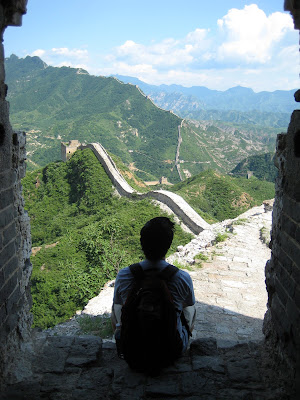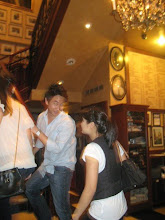I apologize for the lack of entries. This time, there is no overbearing government to blame, only myself. I just got back from a trip to Shanghai (shout-out to Katy!), and before that, I was horseback riding on the mountains of Inner Mongolia. But one at a time. (As you can see, my blogs are extremely backed-up. They'll be up eventually.)
First, the Great Wall. A requisite trip for every traveler's itinerary, today's Great Wall of China spans 4,000 miles, making it one of the largest feats of mankind in the history of the world. It was originally built around 200 BC by Shi Huangdi of the Chin Dynasty to keep out nomadic tribes. 200 BC -- that's 200 years before Christ.
It's said that at the time of its construction, there were 1 million inhabitants of the nascent nation-state. Estimates stipulate that 250,000 people, or, a quarter of the population worked on the Great Wall. Now, according to my sketchy mathematics and questionable analysis, there is a 25% chance that your ancestor (if you're Chinese) worked on the Great Wall. This notion of ancestry resonated within me throughout the trip.
I had been to the Great Wall once before in my life. It was eight years ago, and that time, vendors, children, tourists littered the wall. This time it was completely different. Our program director described the visit as a 10k hike to a part of the wall that rarely had visitors. 10k is long, I thought, but it's the Great Wall -- lots of tourists, we'll go slow, it'll be flat, it'll be OK! I was completely wrong. The hike was grueling, exhausting, punishing: at times regrettable but at times incredible. 10 k is fine, but the Wall kept going up and up and up.
It was like climbing crumbling collapsing stairs for 10 kilometers.

We were dropped off by bus, to the section of the wall tourists usually do not venture. The section of the Wall we hiked, known as Jinghanling, was prohibited to the general public because of the large number of accidents foreign tourists were receiving. (That day, in fact, a tourist fell and broke his leg and had to be carried away on a stretcher by hired peasants that farmed corn near the wall.)

But thanks to a new law that prohibits people from suing for accidents originating in China's national historic landmarks, the dangerous portion of the Wall had reopened.

The 2,000 year old wall was crumbling, broken, and awash in lost memories and forgone pasts.
Some parts were stolen by peasants that needed to build homes and some parts were stolen by the passages of time. But the Great Wall is so much more than the sum of its parts.
There were other peasants that kept trying to offer to carry our bags or sell us water.
Suffice it to say, the 10k hike was extremely dangerous with absolutely no protection to protect an unassuming traveler from a 20 ft. drop and a swift break to the neck.
But it was this pure, unadulterated, untainted, unforgiving quality of the wall that made this experience so incredible.

For miles around, we were the only people to be seen. No obnoxious tour groups, no loud guides, it was complete silence except for the sounds of nature and our tiresome pants. To know that my view may have been the same view of my ancestors, that these mountains were the same ones that occupied this landscape thousands of years ago, that the very brick my feet stood on was laid by my ancestors ... It was surreal.




































